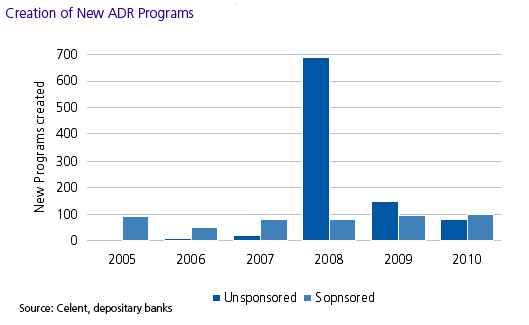What are American Depositary Receipts (ADRs) Market Business News
Post on: 14 Июнь, 2015 No Comment

Stocks of foreign companies that trade in American markets are known as American Depositary Receipts (ADRs). ADRs are exchanged in U.S. dollars, through a U.S. broker-dealer, and during U.S. trading hours.
These are certificates issued by a US depository bank that represent securities of a foreign company trading in an American financial market. According to the SEC, investors often find it more convenient to own ADRs than the foreign stock itself. This is because investors can benefit from the protection and transparency facilitated by U.S. securities regulation.
ADRs are created when brokers buy foreign securities directly in the local market and then provide the shares to a depository bank, such as Citibank, JP Morgan, Deutsche Bank, or BNY Mellon, who then issue the ADRs to US markets.
For the foreign issuer ADRs allow them to have access to a new market with minimum disclosure and attendant potential liability. For investors it allows them to own foreign securities with the same advantage associated with owning securities from U.S. issuers.
ADRs are traded on U.S. national stock exchanges, including the New York Stock Exchange (NYSE), the Nasdaq Stock Market, NYSE Alternext (AMEX) and on the US OTC (over-the-counter) market.
Upon ownership of an American Depositary Receipt the owner has the right to obtain stock of the foreign company it represents.
There are two main types of American depositary receipts: sponsored receipts and unsponsored receipts. However, the trend in recent years has been toward sponsored arrangements.
The term ADR and ADS (American Depositary Shares) are frequently used interchangeably. However, an ADR is the certificate that represents an ADS.
The first ADR in the United States was introduced by the British retailer Selfridges in 1927 through the bank J.P. Morgan.
According to BNY Mellon, the reduction of global trading & custodian charges associated with depository receipts saves between 10 to 40 basis points annually.
According to BNY Mellon: “The demand by investors for Depositary Receipts has been growing between 30 to 40 percent annually, driven in large part by the increasing desire of retail and institutional investors to diversify their portfolios globally. Many investors who do have the capabilities to invest outside the U.S. may prefer to utilize Depositary Receipts because of the convenience, enhanced liquidity and cost effectiveness Depositary Receipts offer compared to purchasing and safekeeping ordinary shares in the home country. In many cases, a Depositary Receipt investment can save an investor up to 10 – 40 basis points annually, compared to the costs associated with trading and holding ordinary shares outside the United States.”
Sponsored ADRs
Sponsored ADRs are usually provided with some form of assistance by the bank to subsidize the administration of owning the security and are subject to reporting requirements by the U.S. Securities and Exchange Commission (SEC).
They are created jointly by a foreign private issuer and a depository. The foreign issuer is required to sign a Form F-6 registration statement and enters into an agreement with the depositary, which governs the rights and responsibilities of the two parties and establishes the allocation of fees.
There are 3 levels of sponsorship:
- Level 1: these do not need to be registered with the SEC or conform to generally accepted accounting principles (GAAP). Level 1 ADRs can only be traded over the counter and are considered to be riskier than the other levels of sponsorship.
- Level 2: these have to be registered with the SEC and partially comply with GAAP.
- Level 3: these have to be registered with the SEC and completely comply with GAAP. A Level 3 sponsorship is necessary if the ADR is a primary offering used to raise money for the company.
Unsponsored ADRs
Unsponsored ADRs, on the other hand, do not receive much assistance and are traded on the over-the-counter (OTC) market. They are also issued by a depositary bank, however, there is no direct involvement of the non-U.S. company. Therefore, the main factor driving unsponsored ADR programs is investor demand.

In the case of unsponsored ADRs the depositary is required to file a registration statement under the Securities Act of 1933 on Securities Act Form F-6. As soon as the statement goes into effect then the depositary is able to accept deposits of securities of a foreign private issuer and then issue ADRs.
It is a common misconception to think that unsponsored ADRs are only for small foreign companies but this is not true as there are ADRs for some of the worlds largest companies, including BMW, Nestle, and Adidas.
How ADR prices are determined
The price of an ADR depends on the price of the stock in its home market, adjusted to the ratio of foreign company shares to ADRs. An ADR can represent a fraction of a share, a single share, or multiple shares of a foreign security.
The dividends of ADRs are paid in US dollars and can essentially be traded exactly like regular shares.
For example, assume that the demand for English chocolate surges in the US and as a result a British confectionary company wants to list its shares on the NYSE to expand its market exposure. Shares of the company trade on the London Stock Exchange for £3.00 (equivalent to approximately $4.80). If a US bank buys 50 million shares and issues them in the US at a ratio of 15:1, then the ADR will have an issue price of $72 ($4.80 times 15).
The benefits of ADRs for issuers
- Gain access to capital in the U.S.
- Have more corporate visibility in the U.S.
- Diversify shareholder base.
- Expand their share market, improving global liquidity.
- Make it easier for M&A activities, using ADRs as an acquisition currency.
- Create a share plan for American employees.
The benefits of ADRs for investors
- Diversify an investment portfolio on a more global scale.
- Exchange according to American conventions.
- No charges associated with cross-border custody/safekeeping.
- Receive dividend payments in American dollars.
- Better accessibility of research, price and trading information.
For example, if an investor wants to go to England and buy shares of the oil giant BP they would have to have a British brokerage account and have a mechanism to turn dollars into pounds sterling. The securities would have to be held in London and the investor would receive dividends in pounds sterling.
From an investor point of view an ADR would give them the same equity exposure to BP as ExxonMobil, with dividend payments in dollars and the ability to trade it in dollars. This essentially Americanizes the security and makes it transparent from an investor point of view as to whether you are holding something from Switzerland, England, or a home market security.
The size of the ADR market
At the beginning of 2013 there were approximately 2,590 ADRs (1,246 Sponsored / 1,344 Unsponsored). In 2009 there were 2,033 ADRs (1,124 Sponsored / 909 Unsponsored) and in 2007 there were 1,256 ADRs (1,127 Sponsored / 129 Unsponsored). Around two thirds of ADRs are in developed markets, with one third in emerging markets.














